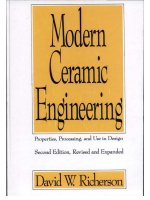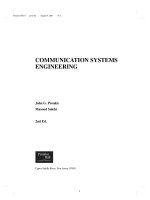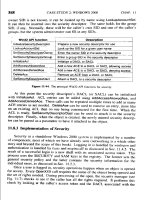modern ceramic engineering 2nd richerson
Bạn đang xem bản rút gọn của tài liệu. Xem và tải ngay bản đầy đủ của tài liệu tại đây (18.23 MB, 846 trang )
•
•
Properties, Processing, and
Use
in
Design
Second
Edition,
Revised
and
Expanded
Contents
Prel."
to the Second Edilion
Preface to the First Edition
Introd.dion
Pad
I
STRtlCfllRES
AND
PROPERTIES
1 Atomic: Bonding, and Crystal Structure
•
vii
xi
I
3
2 Crystal Chemistry
and
Speci6c Crystal Structures 32
3 Phase EguUibria and
Phue
Equilibrium Diagrams
71
4
PbysicaJ
and }bennal Behavior
123
5
Mrtblola!
Bcbuior
and
Measurement 162
6
EI.drirl'
Behayio[
204
1 Dieledric
t
Magnetic. and Optical Behavior
1S1
8 Time, Temperature, and Environmental Elred!
on
PropeJ1Jes
313
Part
II
PROCF,sSING
OF
CERAMICS
373
9 Powder Processing
10
Shape·FonnlllR Processes
J 1
D'nqfinlinn
12
Final Macbining
13 Quality Assurance
pad
II(
DESIGN
WITH
CERAMICS
14
DesI&n
Considerations
15
Deslp
Approaches
16
FaOure
Analysis
17 TougbeDing of Ceramics
18
AppUalions: Material Selection
Glossary
EWed:ive
Ionic
Radii
(or
CalioD'
aod
AniOBS
periodic
Table
of
the
Elements
lode
x
374
418
519
5%
6ZO
649
651
662
680
731
808
833
843
851
Chapter 1
The
second
shell
h
as
eight
e
lectron
s.
two
in
s o
rbital
s
and
six
in
p
orb
ital
s.
All h
ave
higher
energy
than
th
e two electrons
in
th
e
first
she
ll
and
are
in
o
rbit
als
farth
er f
rom
the
nucleus
.
(For
in
s
tance
.
the
s o
rbital
s of
th
e seco
nd
shell
of
lithium ha
ve
a spherical probability distribution at about 3 A radius.)
The
p
orb
it
als are not
sp
he
ri
cal. but have dumbbell-shaped probability
di
s-
tributions
along
the
orthogonal
axes,
as
s
hown
in
Fi
g.
1.1.
Th
ese
p
electrons
have
sl
ightly
hi
gh
er
energy than s electrons
of
the same she
ll
and are
in
pairs
with oppos
it
e sp
in
s along each
ax
is when the she
ll
is full.
The
third quantum shell has d orbitals
in
addition to
sand
p orbital
s.
A
f
ull
d orbital conta
in
s
10
electrons.
Th
e fourth and fifth she
ll
s contain f
orb
itals
in
addition to
s.
p. and d orbitals. A
full
f orbital contains
14
electrons.
A s
imple
notation
is u
sed
to
show
the
electron
confi
g
uration
s
within
s
hell
s.
to sh
ow
the
relative
energy
of
the
electrons,
and
thus
to
s
how
the
o
rd
er
in
which
th
e electrons
ca
n
be
added
to
or
removed
from
an a
tom
during
bond
ing
.
This notation can best be
illu
st
rated
by
a few exa
mpl
es.
Example 1.1 Oxygen
ha
s eight electrons a
nd
h
as
the
electron notation
Is'2s'2p'.
Th
e I and 2 preceding the
sa
nd
p designate the quantum shell.
the
sa
nd
p designate the subshe
ll
wi
thin each quantum she
ll
. and the s
u-
perscripts
designate
the
to
tal
number
of e
lectron
s
in
each
s
ub
she
ll.
For
oxygen
the Is a
nd
2s
subshells are both full. but the
2p
subshell is two electrons short
of
being full.
Example
1.2
As
the
a
tomi
c
number
and
th
e
number
of electrons
increase
.
the
energy
difference
between electrons
and
be
tw
een s
hell
s
decreases
and
over
l<
.lp
between
quantum
gro
up
s
occurs.
For
example
.
the
45 s
ub
s
hell
of
iron
lill
s before the
3d
subshe
ll
is full. This is shown
in
the electron notation by
Figure 1.1 El
ec
tron probability distributions for p orbital
s.
The
hi
gh
es
t probability
electron
pos
iti
ons
are along the orthogon
al
axes.
Two
electrons.
each
with opposite
s
pin.
are
associated
with
eac
h
axis.
resulting
in
a
to
tal
of
six
p el
ect
r
ons
if
all
th
e
p orbitals in
th
e shell are filled .









